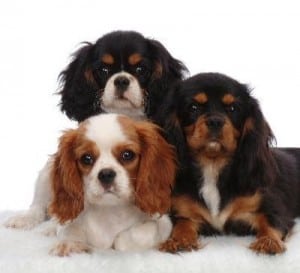From the desk of Sharda Baker
Good day and welcome everyone!
This is Sharda with another Cavalier King Charles Spaniel newsletter.
Here we go!
Bringing home a full-grown dog does not need quite as much attention to detail as bringing home a puppy.
A grown Cavalier King Charles Spaniel will most likely be completely house broken, and will be trained to be in the house and behave appropriately.
It is important to not take this for granted, however,Talk to the owner or to the rescue shelter workers and find out how the dog has behaved in the shelter or at the home.
SUPPLIES
You will need basic supplies when bringing home a full-grown Cavalier King Charles Spaniel. The benefit is that you already know how big the dog will get, so hopefully you will only need to purchase one set of the basics. You will need:
- A good quality hard plastic or stainless dish for water and one for food. Make sure they are sturdy and do not tip easily.
- A kennel or crate for the dog to stay in at night. Many people prefer the dogs to have a crate, kennel or bed as opposed to sleeping elsewhere in the house. This is a personal preference, and may not be required.
- Washable bedding material for the bed, crate or kennel.
- A collar, identification tag and lead for the dog. The collar should be loose enough that two fingers can easily be inserted between the collar and the dog’s neck. For larger breeds, a chain collar may be used, but care must be taken when using one. A retractable leash or lead is ideal for allowing the animal to roam while still maintaining control.
- High quality dry dog food. It is a good idea to start with the same brand that the dog is currently eating. If you wish to change brands, do so gradually. Start by adding 1 part new dry food to 3 parts of the old. Gradually over a two or three week period, increase the new food and eliminate the old food. Watch for changes in the animals eating and fecal production. If you notice any signs of diarrhea or other stomach conditions, discontinue the new food.
- A few sturdy dog toys are always a great idea to keep the dog entertained and busy when you are not at home.
PREPARING YOUR HOME
If you have other pets in the home it is important to make sure that they are kept separate from your new Cavalier King Charles Spaniel until you can properly socialize the animals.
This is important if you have dogs or cats, as you want their first contact to be positive and free from fighting or chasing.
In addition you may wish to dog-proof your house until you get a clear idea of how the animal will behave in your home. Remove any chewable or leather items from the area the dog will be in.
In addition, remove any fragile or delicate items until appropriate behavior in the home is clearly demonstrated. Remember that this is a new home to the dog, and they will be excited or stressed, and may revert back to puppy-like behavior for the first few days.
Check for electrical cords, items hanging off tables and food items that may be tempting to dogs to chew on. Once the dog has demonstrated that it is able to behave in the house these items can be returned to the room.
It is important to talk to your children about the new dog. Children will naturally want to pet and play with the new animal. The dog may not be used to children, or may need time to adjust before being introduced to kids and other family members.
Avoid over exciting or stimulating the dog for the first few days. Keep the people interacting with the dog to a minimum to allow them to get used to the house and their new family.
WHAT TO EXPECT
When you first bring your new Cavalier King Charles Spaniel to the house, make the experience positive. Have all the basic supplies in the house and establish an area for the dog within the first few hours. Plan to have the dog examined by a veterinarian within the first day or two.
For the first week to two weeks, expect the dog to be slightly nervous and uncertain of commands. You may note that female Cavalier King Charles Spaniels tend to be more anxious and male dogs will be more aggressive at this time.
It is important to quickly establish that you are the master, and reward all compliance in a positive manner.
After the second week, the dog should have adjusted to the new home and family. At this time you may find that there is some re-training needed if the Cavalier King Charles Spaniel has bad habits that have not been corrected. Taking the dog to a trainer or a dog obedience class is an option to correct these issues.
Re-training is often harder than the original training, so it may be necessary to get some professional help. Research a good obedience trainer in your area, or ask for recommendations from the rescue shelter, veterinarian or individual you obtained the dog from.
Plan to spend as much time as possible with your Cavalier King Charles Spaniel. This is pleasant for you and the dog, and a strong bond will form over the weeks and months that follow.
Many breeds respond better to one owner, and it may take longer for the bonding to occur. Be patient and positive with your new dog, and you will soon have a friend for life.
I hope that you learned a lot from today’s adult Cavalier King Charles Spaniel newsletter
All the best and take care
Warmly,
Sharda Baker

